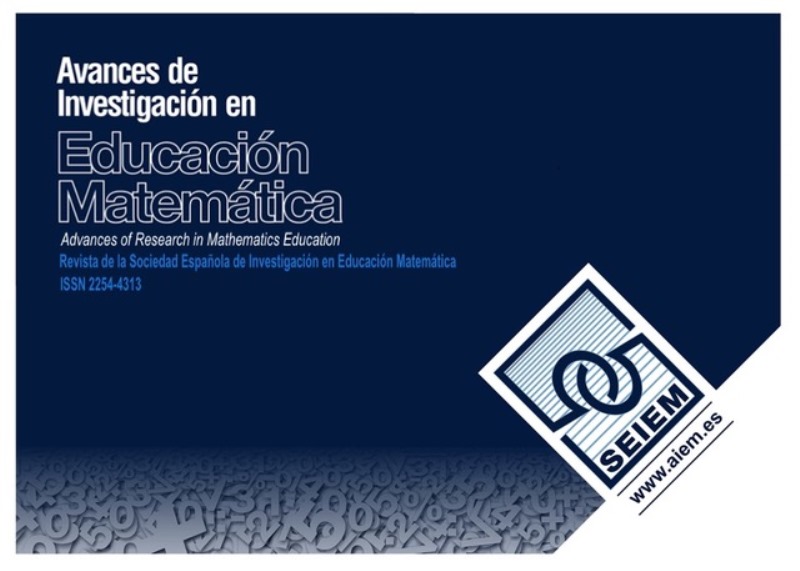Slow Reveal Graphs y niveles de lectura de gráficos en la formulación de problemas estadísticos
DOI:
https://doi.org/10.35763/aiem28.7549Palabras clave:
Estadística, Formación inicial del profesorado, Formulación de problemas, Niveles de lectura de gráficos estadísticosResumen
La formulación de problemas fomenta la comprensión y resolución de problemas, pero su aplicación en estadística es limitada en la literatura. Este estudio analizó cómo 164 Estudiantes para Maestro/a (EPM) formularon problemas estadísticos basados en los niveles de lectura de gráficos, siguiendo el enfoque Slow Reveal Graphs. Los resultados mostraron que los y las EPM son capaces de contextualizar sus propuestas, alinearlas con el currículo y usar un lenguaje adecuado, pero que cometen errores al identificar los niveles de lectura. El estudio supone una línea novedosa en educación estadística que señala cómo reforzar el conocimiento didáctico-matemático de los y las EPM en formulación de problemas y niveles de lectura de gráficos.
Descargas
Citas
Abaev, D. (2022, 30 de noviembre). The Best European City for McDonald’s According to Google Maps Reviews [Entrada de blog]. Slow Reveal Graphs. https://slowrevealgraphs.com/2022/11/30/the-best-european-city-for-mcdonalds-according-to-google-maps-reviews/
Aldrich, F., & Sheppard, L. (2001). Tactile graphics in school education: Perspectives from pupils. British Journal of Visual Impairment, 19(2), 69–73. https://doi.org/10.1177/026461960101900204
Alsina, Á., & Vásquez, C. (2024). Itinerarios de enseñanza de la estadística (3-12 años): Una herramienta para el diseño de tareas. UNO, 104, 8–14.
Alsina, Á., Vásquez, C., Muñiz-Rodríguez, L., & Rodríguez-Muñiz, L. J. (2020). ¿Cómo promover la alfabetización estadística y probabilística en contexto? Estrategias y recursos a partir de la COVID-19 para Educación Primaria. Épsilon, 104, 99–128.
Anderson, L. W., & Krathwohl, D. R. (2001). A taxonomy for learning, teaching, and assessing: A revision of Bloom’s taxonomy of educational objectives. Addison Wesley Longman, Inc.
Arnold, P. (2008). What about the P in the PPDAC cycle? An initial look at posing questions for statistical investigation. En M. Santos & Y. Shimizu (Eds.), Proceedings of the 11th International Congress on Mathematical Education (ICME-11) (pp. 1–8). ICMI.
Arnold, P., & Franklin, P. (2021). What makes a good statistical question? Journal of Statistics and Data Science Education, 29(1), 122–130. https://doi.org/10.1080/26939169.2021.1877582
Arteaga, P., Batanero, C., Contreras, J. M., & Cañadas, G. R. (2015). Statistical graphs complexity and reading levels: A study with prospective teachers. Statistique et enseignement, 6(1), 3–23. https://doi.org/10.3406/staso.2015.1301
Bargagliotti, A., Franklin, C., Arnold, P., Gould, R., Johnson, S., Perez, L., & Spangler, D. A. (2020). The Pre-K-12 Guidelines for Assessment and Instruction in Statistics Education II (GAISE II). American Statistical Association.
Burgos, M., Tizón-Escamilla, N., & Chaverri, J. (2024). A model for problem creation: Implications for teacher training. Mathematics Education Research Journal, 37, 55–84. https://doi.org/10.1007/s13394-023-00482-w
Cai, J., & Hwang, S. (2020). Learning to teach through mathematical problem posing: Theoretical considerations, methodology, and directions for future research. International Journal of Educational Research, 102, 1–8. https://doi.org/10.1016/j.ijer.2019.01.001
Cai, J., & Hwang, S. (2021). Teachers as redesigners of curriculum to teach mathematics through problem posing: Conceptualization and initial findings of a problem-posing project. ZDM Mathematics Education, 53, 1189–1206. https://doi.org/10.1007/s11858-021-01309-3
Cai, J., & Leikin, R. (2020). Affect in mathematical problem posing: Conceptualization, advances, and future directions for research. Educational Studies in Mathematics, 105, 287–301. https://doi.org/10.1007/s10649-020-10008-x
Cañadas, M. C., Molina, M., & del Río, A. (2018). Meanings given to algebraic symbolism in problem-posing. Educational Studies in Mathematics, 98, 19–37. https://doi.org/10.1007/s10649-017-9797-9
Chapman, O. (2012). Prospective elementary school teachers’ ways of making sense of mathematical problem posing. PNA, 6(4), 135–146. https://doi.org/10.30827/pna.v6i4.6137
Chavarría-Arroyo, G., & Albanese, V. (2023). Contextualized mathematical problems: Perspective of teachers about problem posing. Education Sciences, 13(6), 1–15. https://doi.org/10.3390/educsci13010006
Crowther, David. (2024, 12 de noviembre). Netflix Keeps Pulling Ahead of the Competition: Paid Streaming Subscribers, by Platform [Entrada de blog]. Slow Reveal Graphs.
Curcio, F. R. (1989). Developing graph comprehension. NCTM.
Díaz-Levicoy, D., Parra-Fica, J. H., Aravena-Díaz, M., & Gutiérrez-Saldivia, X. (2021). Lectura de gráficos estadísticos por profesores de educación primaria en activo. Información Tecnológica, 32(3), 57–68.
https://doi.org/10.4067/S0718-07642021000300057
English, L. D., & Watson, J. M. (2015). Statistical literacy in the elementary school: Opportunities for problem posing. En F. Singer, N. Ellerton, & J. Cai (Eds.), Problem posing: From research to effective practice (pp. 241–256). Springer. https://doi.org/10.1007/978-1-4614-6258-3_11
Friel, S., Curcio, F., & Bright, G. (2001). Making sense of graphs: Critical factors influencing comprehension and instructional implications. Journal for Research in Mathematics Education, 32(2), 124–158. https://doi.org/10.2307/749671
Instituto Cántabro de Estadística (2025). Censo de Ganado. Consejería de Desarrollo Rural, Ganadería, Pesca y Alimentación. Gobierno de Cantabria. https://www.icane.es/data/cattle-exploitation-municipal
Instituto Nacional de Estadística (2023a). Fenómenos demográficos por tipo de fenómeno demográfico.
https://www.ine.es/jaxiT3/Datos.htm?t=6566#_tabs-grafico
Instituto Nacional de Estadística (2023b). Viajeros por motivos personales 2024.
Instituto Nacional de Evaluación Educativa. (2022). Marco para pruebas de matemáticas. PISA 2022. OCDE.
Leavy, A., & Frischemeier, D. (2022). Developing the statistical problem posing and problem refining skills of prospective teachers. Statistics Education Research Journal, 21(1), 1–27. https://doi.org/10.52041/serj.v21i1.226
Leavy, A., & Hourigan, M. (2022). The framework for posing elementary mathematics problems (F-PosE): Supporting teachers to evaluate and select problems for use in elementary mathematics. Educational Studies in Mathematics, 111, 147–176. https://doi.org/10.1007/s10649-022-10155-3
Lee, E. J., & Park, M. (2019). Statistical reasoning of preservice elementary school teachers engaged in statistical problem solving: Focused on question posing stage. Education of Primary School Mathematics, 22(4), 205–221.
Liljedahl, P., & Cai, J. (2021). Empirical research on problem solving and problem posing: A look at the state of the art. ZDM Mathematics Education, 53, 723–735. https://doi.org/10.1007/s11858-021-01291-w
Makar, K., & Fielding-Wells, J. (2011). Teaching teachers to teach statistical investigations. En C. Batanero, G. Burrill, & C. Reading (Eds.), Teaching statistics in school mathematics—Challenges for teaching and teacher education (Vol. 14, pp. 347–358). Springer. https://doi.org/10.1007/978-94-007-1131-0_33
Mallart, A., Font, V., & Diez, J. (2018). Case study on mathematics pre-service teachers’ difficulties in problem solving. Eurasia Journal of Mathematics, Science and Technology Education, 14(4), 1465–1481. https://doi.org/10.29333/ejmste/83682
Martín-Díaz, J. P., & Montes, M. (2022). Conocimiento especializado para la enseñanza a través de la formulación de problemas en educación infantil. Uniciencia, 36(1), 1–19. https://doi.org/10.15359/ru.36-1.37
Melo, M. F. (2023, 8 de agosto). Las mascotas preferidas por los españoles [Entrada de blog]. Statista.
https://es.statista.com/grafico/30552/cantidad-de-mascotas-en-espana/
Ministerio de Educación y Formación Profesional. (2022). Real Decreto 157/2022, de 1 de marzo, por el que se establecen la ordenación y las enseñanzas mínimas de la Educación Primaria. Boletín Oficial del Estado, 52 (2 de marzo de 2022), 24386–24504.
Muñiz-Rodríguez, L., Rodríguez-Muñiz, L. J., & Alsina, Á. (2020). Deficits in the statistical and probabilistic literacy of citizens: Effects in a world in crisis. Mathematics, 8(11), 1872. https://doi.org/10.3390/math8111872
National Council of Teachers of Mathematics. (2000). Principles and standards for school mathematics. NCTM.
Rodríguez-Muñiz, L. J., Muñiz-Rodríguez, L., & Aguilar-González, Á. (2021). El recuento y las representaciones manipulativas: Los primeros pasos de la alfabetización estadística. PNA, 15(4), 311–338. https://doi.org/10.30827/pna.v15i4.22511
Rodríguez-Muñiz, L. J., Muñiz-Rodríguez, L., García-Alonso, I., López-Serentill, P., Vásquez, C., & Alsina, Á. (2022). Nadando entre dos orillas: Abstracción y contexto en educación estadística en Secundaria. Culture and Education, 34(3), 689–725. https://doi.org/10.1080/11356405.2022.2058794
Rosli, R., Capraro, M. M., & Capraro, R. M. (2014). The effects of problem posing on student mathematical learning: A meta-analysis. International Education Studies, 7(13), 227–241. https://doi.org/10.5539/ies.v7n13p227
Silver, E. A. (1994). On mathematical problem posing. For the Learning of Mathematics, 14, 19–28.
Watson, J. M., & English, L. D. (2017). Statistical problem posing, problem refining, and further reflection in grade 6. Canadian Journal of Science, Mathematics and Technology Education, 17(4), 347–365. https://doi.org/10.1080/14926156.2017.1380867
Wild, C., & Pfannkuch, M. (1999). Statistical thinking in empirical enquiry. International Statistical Review, 67(3), 223–248.
https://doi.org/10.1111/j.1751-5823.1999.tb00442.x
Wilson, L. O. (2016). Anderson and Krathwohl Bloom’s taxonomy revised: Understanding the new version of Bloom’s taxonomy. The Second Principle, 1(1), 1–8.
Descargas
Publicado
Cómo citar
Número
Sección
Licencia
Derechos de autor 2025 Pablo Giadas, Laura Muñiz Rodríguez, Luis J. Rodríguez Muñiz

Esta obra está bajo una licencia internacional Creative Commons Atribución 4.0.
Los trabajos se publican bajo una licencia de Creative Commons: Reconocimiento 4.0 España a partir del número 21 (2022).
Los autores que publican en esta revista están de acuerdo con los siguientes términos:
- Los autores conservan los derechos de autor y el reconocimiento de la autoría.
- Los textos publicados en esta revista están sujetos –si no se indica lo contrario– a una licencia de Reconocimiento 4.0 Internacional de Creative Commons. Puede copiarlos, distribuirlos, comunicarlos públicamente, hacer obras derivadas y usos comerciales siempre que reconozca los créditos de las obras (autoría, nombre de la revista, institución editora) de la manera especificada por los autores o por la revista. La licencia completa se puede consultar en http://creativecommons.org/licenses/by/4.0.
- Los autores pueden establecer por separado acuerdos adicionales para la distribución no exclusiva de la versión de la obra publicada en la revista (por ejemplo, situarlo en un repositorio institucional o publicarlo en un libro), con un reconocimiento de su publicación inicial en esta revista.
- Se permite y se anima a los autores a difundir sus trabajos electrónicamente (por ejemplo, en repositorios institucionales o en su propio sitio web) antes y durante el proceso de envío, ya que puede dar lugar a intercambios productivos, así como a una citación más temprana y mayor de los trabajos publicados (Véase The Effect of Open Access) (en inglés).
Datos de los fondos
-
Agencia Estatal de Investigación
Números de la subvención PID2021-122180OB-100 -
Agencia Estatal de Investigación
Números de la subvención PID2024-155358NB-100 -
Universidad de Oviedo
Números de la subvención PAPI-22-PF-18









